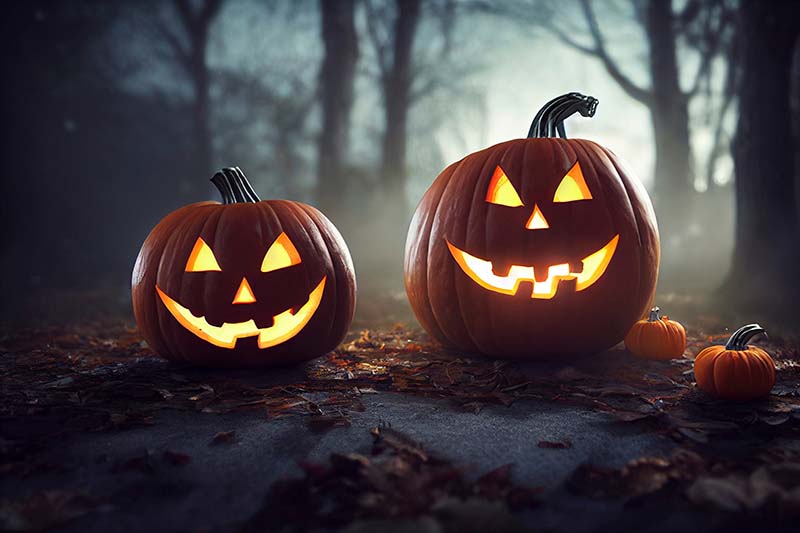
Lifestyle
The Origins of Halloween Traditions
October 31 2022
Carving pumpkins, trick-or-treating, and wearing scary costumes are some of the time-honored traditions of Halloween. Yet, the Halloween holiday has its roots in the ancient Celtic festival of Samhain (a Gaelic word pronounced “SAH-win”), a pagan religious celebration to welcome the harvest at the end of summer, when people would light bonfires and wear costumes to ward off ghosts. In the eighth century, Pope Gregory III designated November 1 as a time to honor saints. Soon after, All Saints Day came to incorporate some of the traditions of Samhain. The evening before All Saints Day was known as All Hallows Eve, and later, Halloween. Here is a look at the origins of some of the classic Halloween traditions we know today.
Carving Jack-o’-Lanterns
The tradition of
carving Jack-o’-Lanterns originated in Ireland using turnips instead of pumpkins. It is allegedly based on a legend about a man named Stingy Jack who repeatedly trapped the Devil and only let him go on the condition that Jack would never go to Hell. But when Jack died, he learned that Heaven did not want his soul either, so he was forced to wander the Earth as a ghost for eternity. The Devil gave Jack a burning lump of coal in a carved-out turnip to light his way. Locals eventually began carving scary faces into their own turnips to frighten away evil spirits.
“In Pumpkin Land the Jack-‘o-Lantern Is Still the Symbol of Hallowe’en,” New York Tribune (New York, NY), October 24, 1915.
Seeing Ghosts
The festival of Samhain marked the transition to the new year at the end of the harvest and beginning of the winter. Celtic people believed that during the festival, spirits walked the Earth. Later on, Christian missionaries introduced
All Souls’ Dayon November 2, which perpetuated the idea of the living coming into contact with the dead around the same time of year.
[No headline]. The Morning Times (Washington, DC), October 25, 1896.
Wearing Scary Costumes
In order to avoid being terrorized by all the evil spirits walking the Earth during Samhain, the Celts donned disguises so that they would not be mistaken for spirits themselves and be left alone.
“Halloween in Retrospect,” The Farmville Herald (Farmville, VA), November 8, 1960.
Trick-or-Treating
There is much debate around the origins of trick-or-treating, but generally there are three theories. The first theory suggests that during Samhain, Celtic people would leave food out to appease the spirits traveling the Earth at night. Over time, people began to dress as these unearthly beings in exchange for similar offerings of food and drink.
The second theory speculates that the candy boon stems from the Scottish practice of guising, which is a secular version of “souling.” During the Middle Ages, generally children and poor adults would collect food and money from local homes in return for prayers for the dead on All Souls’ Day. Guisers dropped the prayers in favor of non-religious practices with the inclusion of songs, jokes, and other “tricks.”
A third theory argues that modern American trick-or-treating stems from “belsnickeling,” a German-American Christmas tradition where children would dress in costume and then call on their neighbors to see if the adults could guess the identities of the disguised. In one version of the practice, the children were rewarded with food or other treats if no one could identify them.
|
“Trick or Treat!,” Evening Star (Washington, DC), October 26, 1952.
|
|
 “Trick or Treat?” Evening Star (Washington, DC), October 28, 1962. “Trick or Treat?” Evening Star (Washington, DC), October 28, 1962. |
Black Cats
The idea of being spooked by black cats dates back to the Middle Ages, when these dark felines were considered a symbol of the Devil. It didn’t help that centuries later, accused witches were often found to have cats, particularly black ones. People began to believe that the
cats were a witch’s “familiar”–supernatural entities that would assist in their practice of dark magic–and black cats and spookiness have been linked ever since.
“Halloween,” Evening Star (Washington, DC), October 27, 1912.
Black and Orange
The traditional Halloween colors of black and orange also traces back to the Celtic festival of Samhain. For the Celts, black represented the “death” of summer while the orange symbolized the autumn harvest season.
Bobbing for Apples
The game of bobbing for apples has been a staple at Halloween parties for many years, but its origins are more rooted in love and romance. The game
traces back to a courting ritual that was part of a
Roman festival honoring Pomona, the goddess of agriculture and abundance. While multiple versions existed, the gist was that young men and women would be able to predict their future relationships based on the game. When the Romans conquered the British Isles in 43 AD, the Pomona festival blended with the similarly timed Samhain, a precursor to Halloween.
“The custom of bobbing for apples…,” Nogales International (Nogales, AZ), October 28, 1939.
Pranking
Playing pranks often varies by region, but the pre-Halloween tradition known as “
Devil’s Night,” is credited to a different origin depending on the source. Some say that pranks started as part of May Day celebrations. But Samhain, and eventually All Souls Day, also included good-natured mischief. When Irish and Scottish immigrants came to America, they brought with them the tradition of celebrating
Mischief Night as part of Halloween.
“Organized Mischief,” Evening Star (Washington, DC), October 28, 1951.
Lighting Candles and Bonfires
For much of the early history of Halloween,
towering bonfires were used to light the way for souls seeking the afterlife. These days, lighting candles have generally replaced the large traditional blazes.
The San Francisco Call (San Francisco, CA), October 29, 1899.
Candy Apples
For centuries, people have been coating fruit in syrup as a means of preservation. But during the Roman festival of Pomona, the goddess was
often represented by and associated with apples; her name derives from the Latin word for apple “pomum” and the fruit is at the heart of harvest celebrations. It is believed that candy apples were invented accidentally in 1908 by William W. Kolb, a candymaker in Newark, New Jersey. As the story goes, Kolb was experimenting with red cinnamon candy to sell at Christmastime and he dipped apples on sticks into the red glaze and put them in his shop window to showcase his new candy. But instead of selling the candies, he ended up selling the apples to customers who thought they looked good enough to eat. They became
fashionable treats for Halloween starting in the early 1900s and they remained popular up until the 1970s.
Candied apples. Evening Star (Washington, DC), October 28, 1956.
Bats
Bats were likely present at the earliest proto-Halloween celebrations, not just symbolically but literally. As part of Samhain, Celts lit large bonfires, which attracted insects, which in turn, attracted bats. Soon spotting bats became connected with the festival. Medieval folklore expanded upon the eeriness of bats with a number of superstitions built around the belief that bats were harbingers of death.
The San Francisco Call (San Francisco, CA), October 29, 1899.
Devouring Candy
The act of going door-to-door for handouts has long been a part of Halloween revelries. But until the mid-20th century, the “treats” children received were not necessarily candy. Things like fruit, nuts, coins, and toys were just as likely to be given out. Trick-or-treating rose in popularity in the 1950s and it inspired candy companies to market small, individually wrapped candies. People began to favor the confections out of convenience, but candy did not dominate at the exclusion of all other treats until the 1970s when parents started fearing anything unwrapped.
“Treat ’em right, don’t be tricked!” Evening Star (Washington, DC), October 24, 1962.
Candy Corn
A candymaker at the Wunderle Candy Company in Philadelphia is sometimes credited with inventing the tri-colored candy in the 1880s. But candy corn did not become a widespread sensation until the Goelitz Company brought the candy to the masses in 1898. Candy corn was originally called “Chicken Feed” and it sold in boxes with the slogan “Something worth crowing for.” Initially, it was just an autumnal candy because of corn’s association with harvest time. Candy corn later became Halloween-specific when trick-or-treating grew in popularity in the U.S. during the 1950s.
“Halloween Candy Corn,” Evening Star (Washington, DC), October 28, 1951.
Source: Library of Congress
























